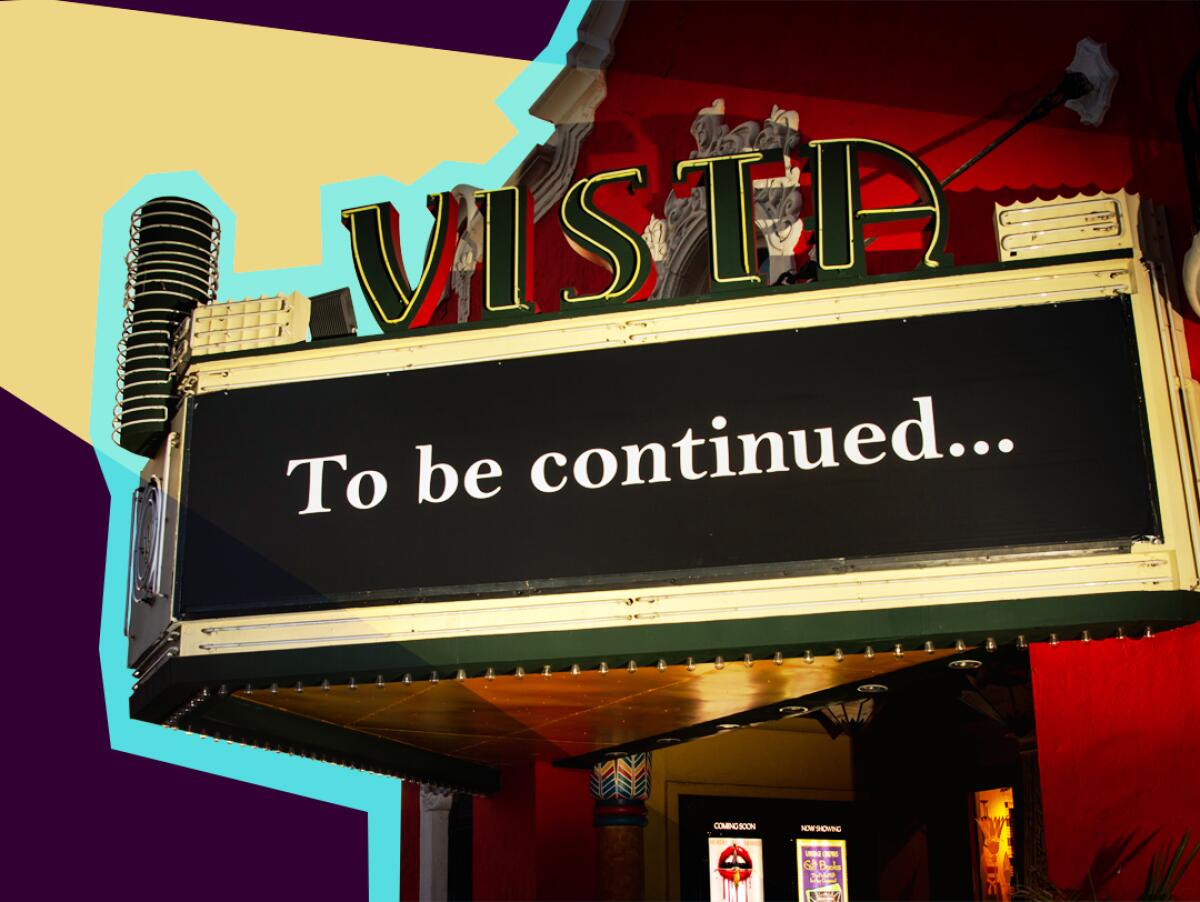California has opened. My beloved local theater hasn’t. Why?

This is the June 22, 2021, edition of The Wide Shot, a weekly newsletter about everything happening in the business of entertainment. Sign up here to get it in your inbox.
In 1993’s “True Romance,” Christian Slater as Clarence and Patricia Arquette as call girl Alabama enjoy a martial arts triple feature at a single-screen Detroit movie theater. Except in reality, it’s not a Detroit cinema; it’s the classic Vista Theatre, on the border of Los Feliz and East Hollywood, serving as a stand-in.
Watching the Vista’s vintage sign lit up on my living room TV recently, I had one of those moments like Leonardo DiCaprio pointing at the screen in “Once Upon a Time ... in Hollywood.” The Vista, built in 1923, is my neighborhood theater, practically walking distance from my home in Silver Lake.
The sight of it was bittersweet. Even with California open for business and movie theater capacity limits lifted, the Vista remains shuttered until further notice, with its wistful “To be continued...” sign still on the marquee.
Why isn’t the Vista open? When I caught up with owner Lance Alspaugh, chief executive of Vintage Cinemas, he expressed a common dilemma faced by small theater operators. He was still waiting for the Small Business Administration to approve his application for badly needed federal government funds.
Assuming the money is approved, the theater will stay closed until at least October or November so the company can make much-needed refurbishments, he said. It could even stay on hiatus through the end of the year.
“We can’t do anything until we know we have the government grant; it’s really that simple,” said Alspaugh, 62, who began managing the Vista Theatre in 1988 before becoming its owner in 1997. He also runs the Los Feliz 3 on Vermont Avenue and Village Theatres in Coronado.
Vintage Cinemas weeks ago applied for the SBA’s $16-billion Shuttered Venue Operators Grant program, established through the Save Our Stages legislation included in the federal government’s COVID-19 relief law passed last year. The funds should’ve been a respite for struggling theater owners and music venues. The size of the grants is determined by the Small Business Administration, and companies are eligible for 45% of revenue lost compared to 2019, up to $10 million. The grants approved so far average $740,000.
But the money has been slow in coming. The program’s bungled rollout, marred by technical snafus starting with a crashed website and followed by repeated delays, has inflicted a brutal headache on movie houses and, as my colleague August Brown explained recently, the live music industry. The situation prompted a letter to the SBA in April that was signed by 57 senators and 107 representatives.
The National Assn. of Theatre Owners this month joined other venue trade organizations in blasting the SBA’s “repeated errors and delays,” saying it has “endangered the very businesses and organizations the program was designed to help.”
The administration has promised to catch up. SBA spokesperson Andrea Roebker said in an emailed statement that the grant applications, some of which include as many as 100 documents, need extensive scrutiny.
“The SBA realizes the critical need to increase processing speed for SVOG applicants — the current pace of awards is not reflective of the high standards that we strive to meet,” Roebker said. “We are committed to doing everything we can to improve funding speed, get Americans the relief they desperately need and open our venues again.”
Alspaugh isn’t “inclined to throw the government — any government, red or blue — under the bus,” though the program was approved in December and as of June 14 had awarded only $304.2 million in funds and approved 411 grants out of more than 14,000 applications. However, the need is dire after more than a year of closures.
“It’s bad that we’re all having to wait, that it’s as slow as it’s been,” he said. “It’s the difference between if you reopen or do you not reopen.”
Some operators have already had to make the hard choice, including the owners of the ArcLight and Pacific circuits. Though larger chains AMC and Regal are starting to pick up Pacific and ArcLight leases (see my colleague Roger Vincent’s scoop), the fate of the Hollywood ArcLight and Cinerama Dome on Sunset Boulevard (another local go-to) remains in limbo. Pacific Theatres Exhibition Corp. on Friday filed for Chapter 7 bankruptcy to liquidate remaining assets with $69 million in liabilities.
Without federal funds, many small-to-midsize exhibitors could meet a similar demise. Theaters are allowed to open virtually everywhere in the U.S., but only about 80% of cinemas have actually reopened their doors, according to data from Comscore. To Hollywood insiders, that’s a sign that some screens probably will never return.
The delays are a dark cloud overhanging marketing efforts by theaters and studios declaring that “the big screen is back.” Tuesday begins Cinema Week, billed as an industrywide celebration of the return to moviegoing, with companies representing 30,000 screens participating.
Theaters are offering discounted popcorn, cheap booze, free upgrades to their subscription programs, early screenings of Questlove’s “Summer of Soul” and anything else they can think of to incentivize people’s return.
Los Angeles-based arthouse circuit Laemmle Theatres is nominally participating in Cinema Week with Wednesday screenings of IFC Films’ “Werewolves Within.” But owner Greg Laemmle said he’s been more focused on getting the grant situation squared away.

He’s one of the lucky ones whose application was approved, though his company has received only a small portion of the promised money (he declined to disclose the amount). Not knowing if and when the rest of the cash is coming makes planning difficult. “I would feel a lot better knowing the status of the remaining 90%,” he said.
Even some larger operators, like Dallas-based Cinepolis USA, are hoping government assistance can help them get back to full speed. One of the challenges businesses face awaking from hibernation is rehiring staffers fast enough to properly serve customers ahead of the launch of big movies like “F9: The Fast Saga,” said Cinepolis USA CEO Luis Olloqui.
“It’s a process,” said Olloqui, who is still awaiting word from the SBA. “The challenge is to have enough employees to serve the people who are coming. And also we’re getting into a period of people getting used to sitting in a theater and sitting next to each other without a face mask.”
Despite some signs of recovery, like the success of Paramount’s “A Quiet Place Part II,” cinemas continue to suffer from slow attendance. Ticket sales in the U.S. and Canada totaled $46.5 million for all films Friday through Sunday, according to Comscore. That’s down 77% from the comparable weekend in 2019, before the pandemic hit.
I loved going back to the movies this weekend for the “Quiet Place” sequel at Laemmle’s Playhouse 7 in Pasadena, but it’s clearly going to take the general public some time to get acclimated.
In the latest sign of where things are going in Hollywood, Steven Spielberg’s Amblin Partners on Monday made a deal with Netflix covering “multiple new feature films per year.” This is particularly interesting coming from a filmmaker who in 2019 wanted to propose rule changes at the Academy of Motion Picture Arts and Sciences that would curb Netflix’s Oscar ambitions.
To compete, theaters have to improve their customer experience. To that end, Vintage Cinemas is hoping to use grant money to redo the floor of the Vista auditorium, replace its curtains and remodel its bathrooms. The last time the Vista got a facelift was in 1999. Los Feliz 3, meanwhile, reopens next month with programming from American Cinematheque, while first-run movies are expected to start in August.
A rainy-day fund made the difference between life and death for the company, said Alspaugh, whose career began when he was a teenage doorman for a Mann theater in Kansas City before moving to Los Angeles to work at Grauman’s Chinese.
Surviving the pandemic has been the biggest challenge of Alspaugh’s professional life. He hadn’t intended to stay in the business for all these years, he said, quoting Al Pacino’s line in “The Godfather Part III”: “Just when I thought I was out ... they pull me back in.”
“I constantly caught myself wondering during the pandemic, ‘Is it time to get offstage?’” he said. “I’m looking forward to getting back, and we’re going to, methodically and slowly.”
Stuff we wrote

— In the latest celebrity-backed education initiative, George Clooney and other A-listers are spearheading a Los Angeles magnet school to train the next wave of “below-the-line” workers from marginalized communities.
— Amazon Studios wants to boost inclusion on its creative teams, Wendy Lee reports. The studio aims for at least 50% of positions on its films and series to be filled by women and people from underrepresented ethnic or racial groups by 2024.
— Justin Chang digs into the new documentary on Rita Moreno’s career, and how it sheds light on the recent “In the Heights” remarks that got her in trouble after a lifetime of trailblazing for Latinos in Hollywood.
— As the COVID-19 pandemic subsides, how will safety rules and protocols change for crews working on film and TV sets? Anousha Sakoui gets into the details.
Quotable, Part I
“Insulation, silence, fear of retribution, self-dealing, corruption and verbal abuse are just a few ways to describe that culture. And as Netflix founder Reed Hastings has said: a workplace culture cannot change. It’s a statement we have seen proven over the past four months.” — the resignation letter of Hollywood Foreign Press Assn. members Diederik van Hoogstraten and Wenting Xu.
The HFPA’s dysfunction again exploded into public view as two members quit following what they described as “window dressing” reform efforts by the Golden Globes group. Read Stacy Perman’s scoop.
Quotable, Part II
“The main reason tracking exists is to measure the efficacy of your advertising campaign. But unfortunately, many people within the industry, and the press, have turned it into a parlor game.” — Kevin Goetz, founder and chief executive of Screen Engine/ASI.
My colleague Ashley Lee wrote an interesting commentary last week about how the practice of using audience tracking surveys in prerelease box office reporting hurt the well-reviewed musical “In the Heights.”
Certainly, the expectations game did no favors for Lin-Manuel Miranda and Jon M. Chu. Nor did attempts to sell “Heights” as the pinnacle of Latino representation in film when it’s very much about a specific community in New York.
Last week, I left open the possibility that rave reviews and word-of-mouth would help “In the Heights” find a broader audience.
They didn’t. Sales for the movie dropped 63% in its second weekend, grossing $4.21 million Friday through Sunday to bring its domestic total to $19.7 million so far. It looks like we can close the book on the theory that this will be the “Greatest Showman” of 2021.
Number of the week

We know Netflix releases more films than any of the major studios. But how many are “hits”? Intriguing new data from Ampere Analysis, published by the Wall Street Journal, looks at Netflix’s batting average in comparison with Hollywood rivals in recent years.
One major takeaway seems to confirm the perception that Netflix prioritizes quantity over quality. The company made 133 movies between 2016 and 2020, but its audience score for those movies was 59.1 out of 100, the lowest of the big distributors Ampere studied. Is this really a problem for Netflix? As long as it keeps drawing subscribers and attracting filmmakers like Spielberg, probably not.
Stories from the week
— It’s about to get real for Apple TV+. Consumers soon may be forced to finally decide whether the tech giant’s service merits its sticker price of $5 per month. (Vulture)
— The Hollywood-ization of Peloton. The internet-connected exercise bike company is turning itself into the “Netflix of wellness.” Fine, but I’m holding out for the Quibi of wellness. (Hollywood Reporter)
— ‘The Beatles: Get Back’: A deep dive into Peter Jackson’s new documentary. Disney+ this fall unveils the three-part documentary, which mines long-lost footage for a portrait of the band’s final chapter. Originally planned as a theatrical release, it will instead be a streaming series. (Vanity Fair)
Finally...
Seeing “A Quiet Place II” and watching “Loki” on Disney+ reinvigorated my appetite for ludicrous hot takes about movies and TV. Luckily, there’s basically an infinite supply of auxiliary podcast content to satisfy that craving.
The latest example is Polygon’s “Galaxy Brains,” a show hosted by Dave Schilling and Jonah Ray “where movies, TV, and overthinking collide,” as the boilerplate pitch describes it. “Overthinking” is certainly a fitting descriptor, though in a way that thankfully avoids swerving into the more toxic elements of online film chatter.
Inside the business of entertainment
The Wide Shot brings you news, analysis and insights on everything from streaming wars to production — and what it all means for the future.
You may occasionally receive promotional content from the Los Angeles Times.




